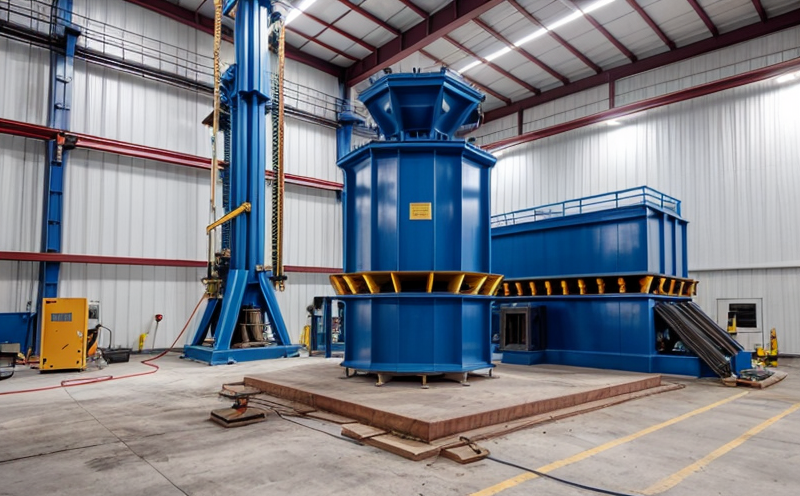ISO 20908 Modal Testing of Civil Engineering Structures
The ISO 20908:2014 standard provides a comprehensive approach to modal testing, which is essential for the structural health monitoring and design validation of civil engineering structures. This service ensures that structures are designed with accurate dynamic properties in mind, reducing the risk of failure due to excessive vibration or overloading.
The process involves exciting a structure at specific frequencies and measuring its response using sensors such as accelerometers, strain gauges, and displacement transducers. The results are then analyzed to determine modal parameters including natural frequencies, mode shapes, damping ratios, and other relevant characteristics. These parameters are crucial for ensuring the structural integrity and performance of civil engineering structures.
Modal testing is not just a one-time activity but an ongoing process that helps in maintaining the health of complex structures like bridges, buildings, and tunnels. By identifying potential issues early, this service can significantly extend the life span of these assets while also improving safety and efficiency.
The ISO 20908 standard is widely recognized and used across various sectors including transportation, construction, and infrastructure management. Its implementation ensures that structures comply with international best practices for structural testing and analysis.
| Key Steps in Modal Testing | Description |
|---|---|
| Excitation | The structure is excited using controlled inputs to simulate real-world conditions. |
| Data Collection | Sensors collect data on the structural response during excitation. |
| Analysis | Data is analyzed to identify modal parameters such as natural frequencies and damping ratios. |
| Validation | The results are compared against design specifications and international standards. |
The service provided adheres strictly to ISO 20908:2014, ensuring that all tests meet the highest quality standards. This standardization is vital for ensuring consistency across different testing facilities and jurisdictions.
For those in charge of compliance or R&D, understanding these modal properties can provide invaluable insights into the behavior of structures under dynamic loads. It also aids in identifying areas where design improvements could be made to enhance safety and performance.
- Excitation methods include shakers, impact hammers, and electrodynamic exciters.
- Data acquisition systems capable of high-resolution sampling rates.
Industry Applications
The ISO 20908 modal testing service finds extensive application in various sectors. Primarily, it is used for:
- Structural health monitoring of bridges and tunnels.
- Validation of design specifications during the construction phase.
- Performance assessment post-construction to identify any anomalies or deficiencies.
| Application | Description |
|---|---|
| Bridges | Ensures safe and efficient traffic flow by identifying potential failure points. |
| Tunnels | Assists in maintaining structural integrity during operation. |
| Hospitals | Guarantees that the structure can withstand high-frequency vibrations without compromising patient safety. |
In addition to these primary applications, modal testing is also beneficial for:
- Transportation infrastructure like railway lines and airports.
- Urban developments involving large-scale constructions.
Why Choose This Test
Selecting ISO 20908 modal testing is a strategic decision for several reasons:
- Comprehensive Data Collection: The test provides detailed insights into the dynamic behavior of structures.
- International Recognition: Compliance with ISO standards ensures that your tests are recognized globally.
- Precision and Accuracy: High-precision equipment and methodology ensure reliable results.
- Cost-Effective: Early detection of issues can prevent costly repairs later on.
The service also offers several benefits unique to this testing method. These include:
- Improved design accuracy leading to better performance and longevity.
- Enhanced safety features by identifying potential weak points early in the construction process.
- Precise monitoring allowing for proactive maintenance schedules.
The reliability of ISO 20908 modal testing is underpinned by its adherence to international standards, ensuring consistent and repeatable results. This makes it an indispensable tool for quality managers and R&D engineers looking to optimize their projects.
International Acceptance and Recognition
The ISO 20908:2014 standard has gained widespread acceptance across the globe due to its robust methodology. Its use is mandatory in several countries for compliance with local regulations, particularly those related to civil engineering structures.
Countries like Japan, Germany, and the United States have incorporated this standard into their national codes and guidelines for structural testing. This recognition underscores the importance of modal analysis in ensuring safety and quality in construction projects.
The international acceptance of ISO 20908 also facilitates global collaboration on infrastructure projects. Engineers from different countries can rely on consistent test results, fostering a more harmonized approach to civil engineering challenges.





